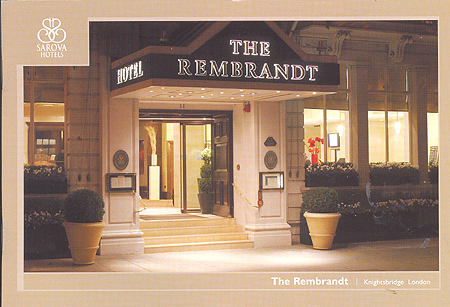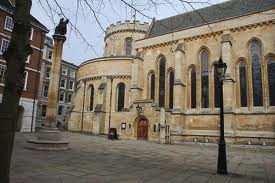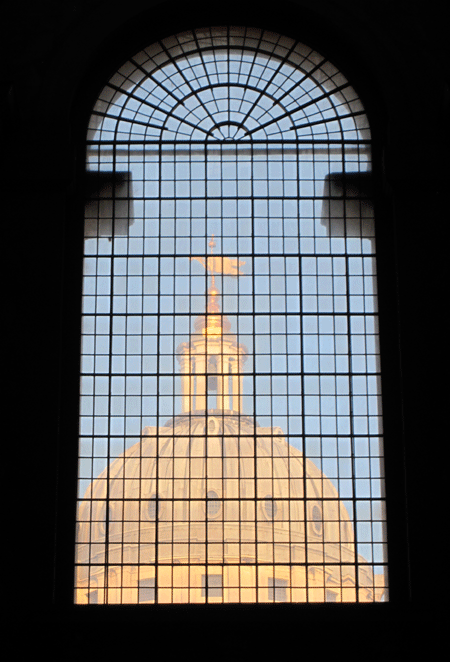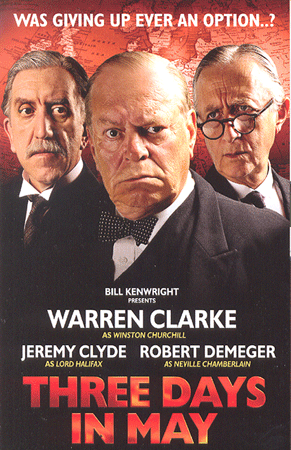
A 'special deal' with British Airways ($175 return including two nights in a London hotel) prompted our short winter getaway.
 Arriving on Thursday morning at 6:25 we quickly traveled to the Rembrandt Hotel in South Kensington.
Arriving on Thursday morning at 6:25 we quickly traveled to the Rembrandt Hotel in South Kensington.
After a short nap, we tubed it to Leicester Square for a pub lunch and strolled the Strand, stopping at St Bride's Church which dates back to the 6th century and, owing to its proximity to Fleet Street - the old home of the British Press - is known as "The Journalists' Church". Sir Christopher Wren rebuilt it after the Great Fire and it was again restored after WWII bombing left it a smoldering shell.

From there, we headed to the Temple Church for a special choral evensong: Candlemas: the presentation of Christ in the temple. This round church, founded in the 12th century by the Knights Templar, one of the most powerful religious military orders during the crusades, is located inside the Temple where many lawyers practice, and is still financially supported in accordance with a legal agreement made centuries ago by their Chambers. For the service, the church was lit by hundreds of candles, the music was hauntingly magnificent, many  elegantly dressed barristers were present, and glasses of wine were served following the service. Walking around the candlelit church sipping wine, we joined in what seemed a privileged, private event undeniably seeped in history and, at the same time, in spiritual meaning.
elegantly dressed barristers were present, and glasses of wine were served following the service. Walking around the candlelit church sipping wine, we joined in what seemed a privileged, private event undeniably seeped in history and, at the same time, in spiritual meaning.
It was dark when we exited the church and wound our way back through the Temple and back to our hotel making a stop at a small lively bistro called Muriel's Kitchen for a glass of wine and an excellent light supper.
We slept well, enjoyed a quite lavish breakfast buffet in the lovely hotel dining room; then, walked across the road to the Victoria and Albert Museum. But the weather was too good - sunny and cool - so we took just a quick look around the museum before deciding to head to Westminster Pier for a Thames boat ride to Greenwich. After passing under many bridges, glimpsing The Tower of London, and noticing many landmarks made familiar through the writings of Charles Dickens (and the mystery novels of Anne Perry), we arrived at Greenwich - the home of Greenwich Mean Time (GMT) and of British naval history.

February 3, the day we visited Greenwich, happened to be the day when Greenwich was officially declared a Royal Borough to commemorate the centuries long link to royalty. In Greenwich Park, which has been a Royal Park since the 15th century stands Greenwich Palace, the birthplace of Henry VIII, which was abandoned in the Civil War and subsequently turned first into a hospital for sailors and then into the Old Royal Naval College. Now Greenwich University, the structure itself stands as a monument to British naval power and three areas remain open to the public. Of these, it was the Painted Hall that took our breath away. This hall is where Admiral Nelson's body was brought after he was killed at Trafalgar.
We also toured the National Maritime Museum which illustrates that battle and documents the history of Britain at sea from the days of early seafarers through the 20th century.
We did not have time to get to the Royal Observatory so cannot claim to have visited the home of Greenwich Mean Time. We rushed to catch the boat so as to get back to London in time to grab tickets to the play we had chosen as the one we most wanted to see and we were in luck. We managed to get two tickets for Three Days in May.
 It takes place at the end of May 1940 behind the closed doors of Number Ten. And it is about what might have happened when the new Prime Minister, Winston Churchill, had assembled the War Cabinet. At that time, giving in to Hitler (by negotiating terms through Mussolini) was being argued by Neville Chamberlain and Lord Halifax as a viable option. The script captures the moment in history when France is about to surrender to Germany, efforts are underway to evacuate troops from the beaches of Dunkirk and one man must decide to reject this option, putting Britain in the position of escalating the battle against fascism - and fighting it alone. The play was great - well scripted and brilliantly acted.
It takes place at the end of May 1940 behind the closed doors of Number Ten. And it is about what might have happened when the new Prime Minister, Winston Churchill, had assembled the War Cabinet. At that time, giving in to Hitler (by negotiating terms through Mussolini) was being argued by Neville Chamberlain and Lord Halifax as a viable option. The script captures the moment in history when France is about to surrender to Germany, efforts are underway to evacuate troops from the beaches of Dunkirk and one man must decide to reject this option, putting Britain in the position of escalating the battle against fascism - and fighting it alone. The play was great - well scripted and brilliantly acted.
After the play we headed back toward our hotel in South Kensington, stopping at a Lebanese restaurant very near the hotel for an excellent meal.
The next morning, since the weather was clear, we ignored the predictions of snow and ice and, after changing hotels, caught a train to Windsor - to see the castle that has been home to the Royal family for 900 years.
Windsor is a charming town but we resisted the temptation to explore and headed straight for the castle which we discovered was more like a walled-in town unto itself. It was much larger and far more magnificent than we had expected - giving a sense of historical continuity that can, perhaps, be best captured by describing St George's Chapel. This medieval church, founded in the 15th century by Edward IV on the site of the original chapel of the Order of the Garter, contains the tombs of ten sovereigns. The remains of Edward IV (1483) are in the altar; Queen Elizabeth II's parents are  entombed in a side chapel; Charles I (beheaded in 1649) and Henry VIII (1547) lie in a flat tomb beneath the floor of the nave. After touring St. George's Chapel, we went to a pub to enjoy a pint before returning for evensong which we had discovered was open to the public.
entombed in a side chapel; Charles I (beheaded in 1649) and Henry VIII (1547) lie in a flat tomb beneath the floor of the nave. After touring St. George's Chapel, we went to a pub to enjoy a pint before returning for evensong which we had discovered was open to the public.
We sat in a Garter Stall beneath the banner, helm, and crest of the Knight or Lady of the Garter whose stall it had been. All Garter Stalls, many carved between 1478 and 1485, are designated and some are assigned to royalty; the Queen's Royal Stall which she occupies when in attendance was directly across from us. Knowing that the body of Henry VIII lay beneath the floor just below us, sensing the "ghosts" of kings, queens, ladies and knights in the stalls, and listening to the haunting music and almost impossibly beautiful voices of the choir, left us suspended in time - and feeling other-worldly.
 As we walked out of the Chapel and back through the Castle gates, it was beginning to snow; the feeling evoked was both mystical and magical. And, while we realized that weather conditions may pose a problem (and later found out that planes at Heathrow had been grounded and all of London, and much of Europe, was struggling to cope with the winter storm), we didn't rush back to London. We stayed to wander a bit in Windsor and to enjoy an excellent dinner before taking the train back to London and settling in for the night.
As we walked out of the Chapel and back through the Castle gates, it was beginning to snow; the feeling evoked was both mystical and magical. And, while we realized that weather conditions may pose a problem (and later found out that planes at Heathrow had been grounded and all of London, and much of Europe, was struggling to cope with the winter storm), we didn't rush back to London. We stayed to wander a bit in Windsor and to enjoy an excellent dinner before taking the train back to London and settling in for the night.
On our final day, the streets were wet and slushie so we spent the day at the Imperial War Museum, touring first the exhibit of those who had been awarded the Victoria Cross and other war medals and then spending several hours in the exhibit focused on the World Wars and on the wars that have erupted since.
Then we headed back to our hotel in Belgravia and out for supper at our favorite local (and familiar) St George's Pub.
The weather was cold (by London standards) but it was clearing as, the next morning we headed for Heathrow and home.